Table of Contents
ToggleIntroduction
The primary reason that has made Python popular among developers and businesses is its high-level programming capabilities with a simple, easy–to–write syntax. This object-oriented language needs no introduction. The versatility and promising scope of Python is evident in its diverse applications and projected growth by 2030. Yet, regardless of whether you are a beginner or a seasoned Python developer, there are times when a Python code you run has taken you by surprise. Python’s easy-to-learn syntax should not be taken for granted. Missing the subtleties of this programming language can lead to coding mistakes. Which is why in this blog, we have a few useful tips and tricks that will help Python programmers to code efficiently.

Don't miss out on your chance to work with the best
apply for top global job opportunities today!
Python at a Glance
Ever since it was created in the late 1980s by the Dutch programmer Guido van Rossum, Python has earned its name as a programming language with extensive applications across domains. As a general-purpose programming language, it is equipped with extensive support modules, libraries, and a large, active developer community. Other than its common usage for web apps and software development, Python is used to build applications for game development, data science, machine learning, and IoT.
Top 12 Python Tips and Tricks
The vast scope of Python hints at the extensive knowledge that developers must have to use the language efficiently. It makes sense, then that developers leverage a few handy Python tips and tricks that are shared through the global community. This would improve code readability, development speed, and resource utilization, ease the learning curve, increase productivity, and reduce maintenance effort.
6 Python Basic-level Coding Tips
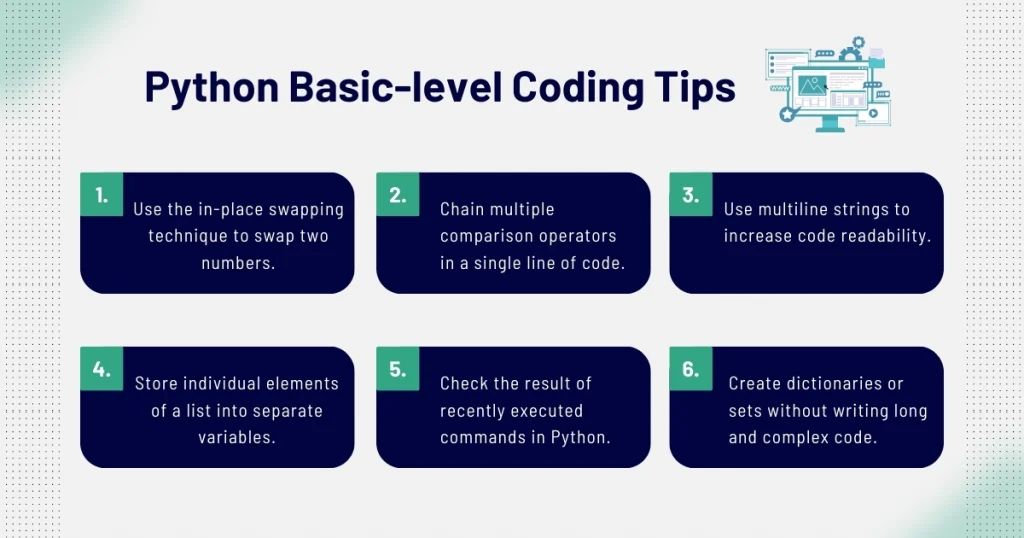
- Use the in-place swapping technique to swap two numbers.
With Python, you can intuitively do assignments and swap in one line.

In the given example, the assignment on the right seeds a new tuple. The one on the left immediately unpacks that tuple to the names <x> and <y>.
The new tuple gets unreferenced and flagged for garbage collection after the assignment follows through. Also, the variables are swapped eventually.
2. Chain multiple comparison operators in a single line of code.
When you chain or aggregate comparison operators, it helps you make your Python code concise and easy to read.

In the given example, the code is easier to read after chaining as it shows three comparisons chained together.
3. Use multiline strings to increase code readability.
While it may be tricky to manage multiline strings in Python, you can span the string to the next line by using a backslash.

Alternatively, you can also enclose the string inside a starting and ending triple quote. However, both methods could lead to incorrect indentation.
A solution to this is splitting the strings into multiple lines and enclosing the entire string in parenthesis.

4. Store individual elements of a list into separate variables.
Use a list to initialize variables. However, ensure that the number of elements in the list should not be more than the count of variables while unpacking.
![testList = [1, 2, 3]](https://ik.imagekit.io/olibr/blogimages/testList-1-2-3-1024x538.webp)
5. Check the result of recently executed commands in Python.
When an expression or function is tested, the result is dispatched to a temporary variable, _ (an underscore). This is a useful hack in the Python console that is worth discovering.
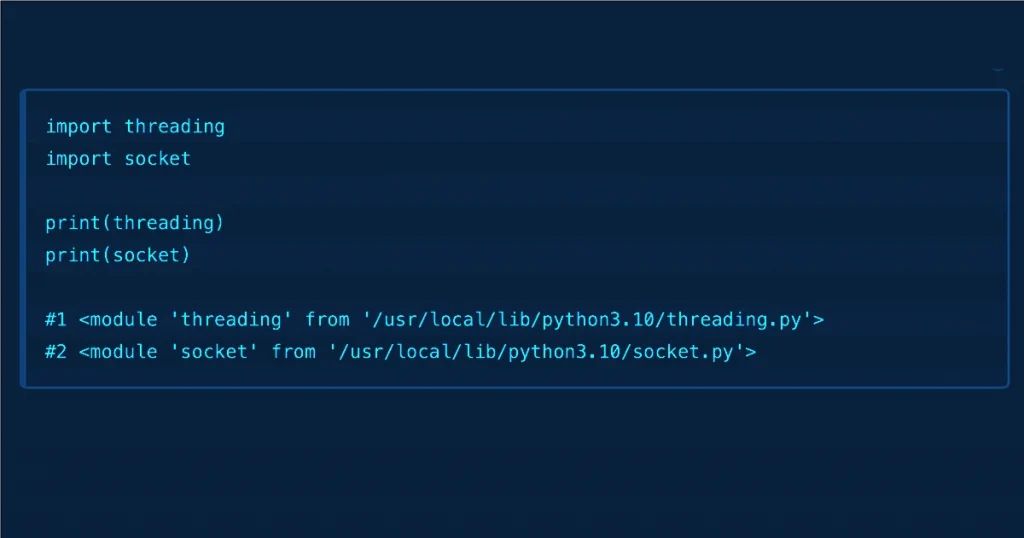
As you can see, in the given example, the output of the last executed expression is referenced through “_”.
6. Create dictionaries or sets without writing long and complex code.
Using dictionary/set comprehensions just like you use list comprehensions.
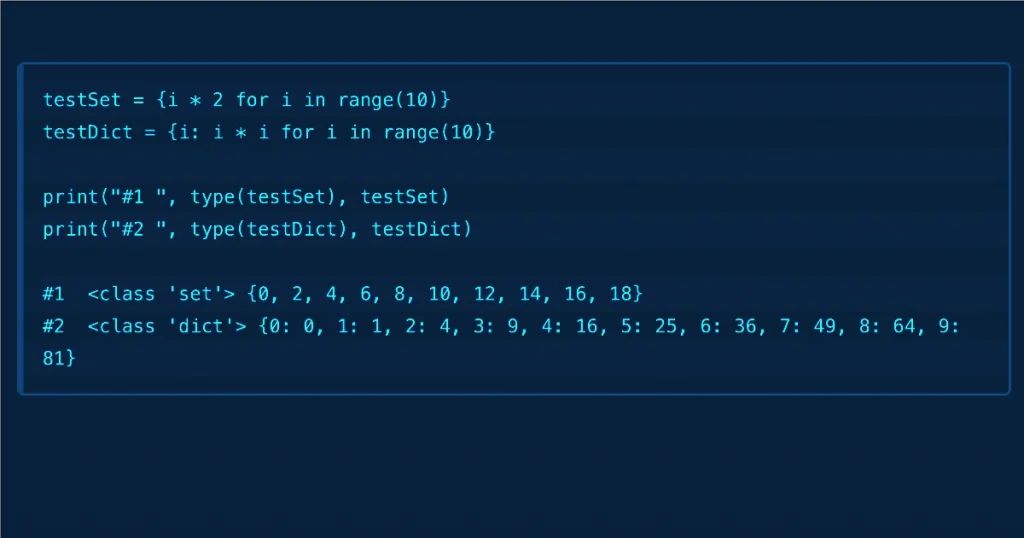
As you can see, the only difference in the two statements is <:>.
6 Python Intermediate-level Coding Tips
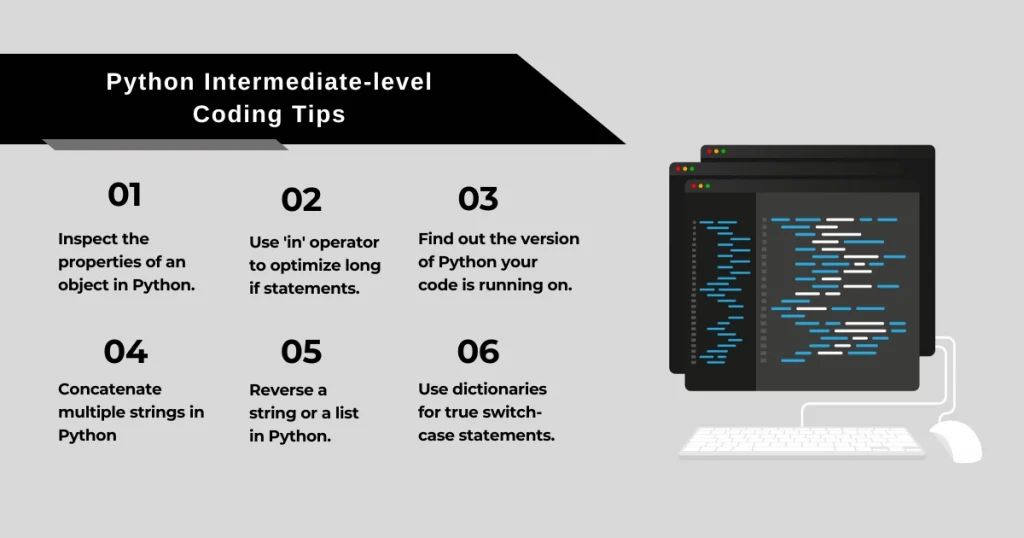
1. Inspect the properties of an object in Python.
![test = [1, 3, 5, 7]](https://ik.imagekit.io/olibr/blogimages/test-1-3-5-7-1024x538.webp)
This example shows how you can inspect objects with the dir() method.
2. Use ‘in’ operator to optimize long if statements.
You can verify multiple values in this manner. Instead of doing this:

You can do this:
![if m in [1, 3, 5, 7]](https://ik.imagekit.io/olibr/blogimages/if-m-in-1-3-5-7--1024x538.webp)
You can use ‘{1,3,5,7}’ instead of ‘[1,3,5,7]’ for the ‘in’ operator because ‘set’ can access each element by O(1).
3. Find out the version of Python your code is running on.
If your Python engine is currently running on a version with limited support, it might not be a good idea to execute your program. You can use this coding snippet, as it also prints the currently used Python version in a readable format.
Output when running on Python 2.7:
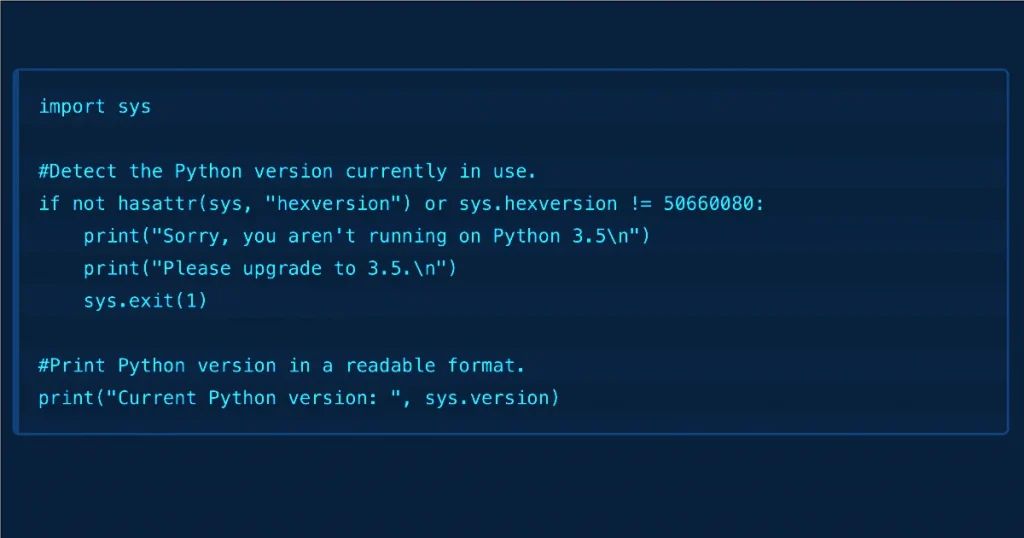
Output when running on Python 3.5:

4.Concatenate multiple strings in Python efficiently.
Here is how you can concatenate all the tokens available in a list. Look at this example.

Here is how you can create a single string from the elements in the above list.
![test = [ 'I', 'Like', 'Python', 'automation']](https://ik.imagekit.io/olibr/blogimages/test-I-Like-Python-automation-1024x538.webp)
5. Reverse a string or a list in Python.
Here are four tips to help you reverse strings or a list in Python. You can choose the method that best suits your ongoing project.
➜Reverse the list itself
![testList reverse= [1, 3, 5]](https://ik.imagekit.io/olibr/blogimages/testList-1-3-5-1024x538.webp)
➜Reverse while iterating in a loop
![for element in reversed ( [1, 3, 5)] ; print (element)](https://ik.imagekit.io/olibr/blogimages/for-element-in-reversed-1-3-5-print-element-1024x538.webp)
➜Reverse a string in line
![print ( '' nohtyp tset'' [ ; ;-1])](https://ik.imagekit.io/olibr/blogimages/print-nohtyp-tset-1-1024x538.webp)
➜Reverse a list using slicing
![print( [1, 3, 5] [ ; ;-1])](https://ik.imagekit.io/olibr/blogimages/print-1-3-5-1-1024x538.webp)
6. Use dictionaries to create a true switch-case statement in Python.
Here is a tip to imitate the switch case statement and make a dictionary to store expressions.

Must Read: Top 14 Trending Python Applications in 2024
How can you become a better Python programmer?
Now that you are equipped with some great tricks and tips to write better Python code, here are a few bonus tips that can help you become a good Python developer.
Tips to Become a Better Python Programmer
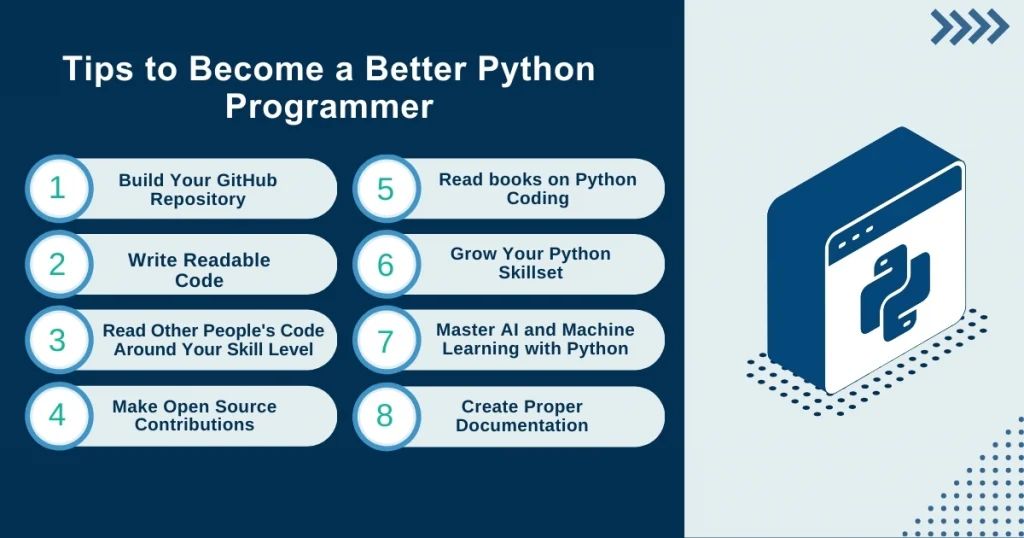
Build Your GitHub Repository
Create and maintain a GitHub repository of your projects and code contributions. You can use it as a portfolio and share it with potential employers or collaborators. Remember to update the repository with new projects and improvements. It demonstrates your commitment to continuous learning and development.
Write Readable Code
A clear, well-documented code that follows PEP 8 style guidelines makes you a reliable programmer. In addition, your peers will find it easier to understand readable code. You can enhance the readability of your code by using meaningful variable and function names, adding comments where necessary, and structuring your code logically.
Read Other People’s Code Around Your Skill Level
Python has a thriving, active developer community. Hence, it makes sense for developers to actively look for code written by their peers. It could help discover different coding styles and techniques. Staying up to date with code written by others could also offer valuable insights into alternative solutions and best practices. GitHub is a platform that has innumerable open-source projects to explore.
Make Open Source Contributions
Python is an open source programming language that receives a lot of input from its community. So, if you have been visiting the platform to find solutions to your coding problems, you should also give back to the community when you can. Collaborate with experienced developers to enhance your skills. Be open to constructive feedback as it improves your credibility in the community and exposes you to real-world coding scenarios and best practices.
Read Books on Python Coding
Even if you are a seasoned Python developer, invest time in sourcing well-regarded Python books. Find time to read these books, as it could help you deepen your understanding of the language. Books often cover fundamental concepts, best practices, and advanced topics. These, along with practical coding practice, can help you become a Python programmer with good foresight.
Grow Your Python Skillset
Keep exploring libraries, frameworks, and tools to expand your Python experience. In addition to reading books, familiarize yourself with the trending Python libraries like NumPy, SciPy, Matpolib, Theono, and TensorFlow. In addition, try to find projects that let you work with different aspects of Python, including web development, data science, and automation.
Master AI and Machine Learning with Python
Just learning Python is not enough. You need to be aware of where it is being used the most currently. Some of the trending Python applications include AI and ML applications. Make time to explore Python libraries that offer solutions for AI, ML, and Data Science projects. Try and find projects that allow you to get hands-on experience with real-world applications of these domains.
Create Proper Documentation
One of the ways of improving the readability of your code is to have proper documentation. A good idea is to have a README file within the GitHub repository. It should have the basic details of the project.
Conclusion
It is very easy to grasp and apply a versatile programming language like Python. However, do not be misled into thinking that all you need to do is use the pre-built tools and modules. Often, the best Python codes can suffer a setback because of common but unnoticeable discrepancies. At such times, apart from a good understanding of the Python syntax, leveraging a set of valuable tips and tricks can enhance your coding efficiency. From basic-level tips that simplify common operations to intermediate-level insights that can optimize code readability and performance, this blog has covered practices that can enhance one’s workflow. Additionally, the bonus tips emphasize the importance of continuous learning, community engagement, and practical exploration of diverse Python applications. By following these guidelines, Python programmers can produce high-quality, efficient code and contribute meaningfully to the collaborative landscape of Python programming.
Take control of your career and land your dream job
sign up with us now and start applying for the best opportunities!

FAQs
Python has many applications, including web development, data science and analytics, scientific computing, machine learning, artificial intelligence, and game development.
NumPy, Matplotlib, SciPy, and Pandas are a few libraries for data science.
Yes, Python is a free, open-source programming language that is available for everyone to use.
Libraries often have their own Python version requirements, so knowing your Python version can help you choose the right libraries for your project.

